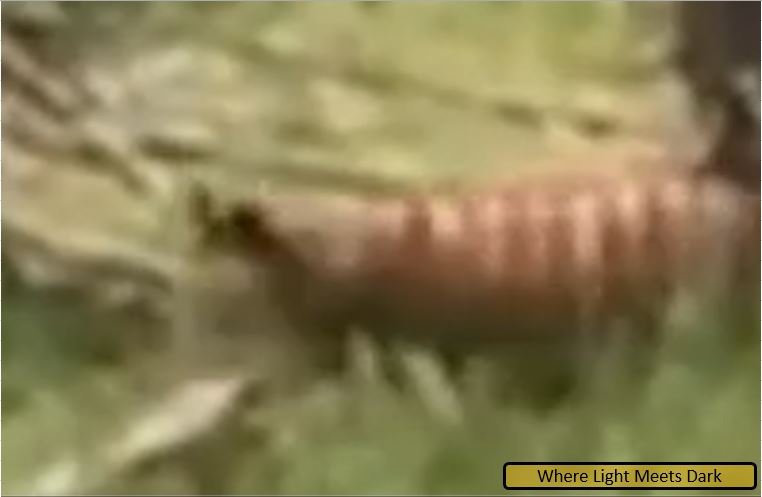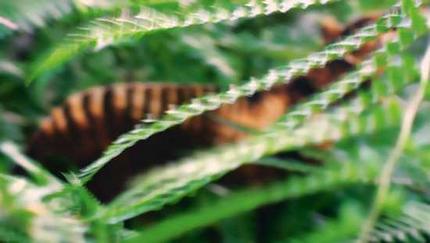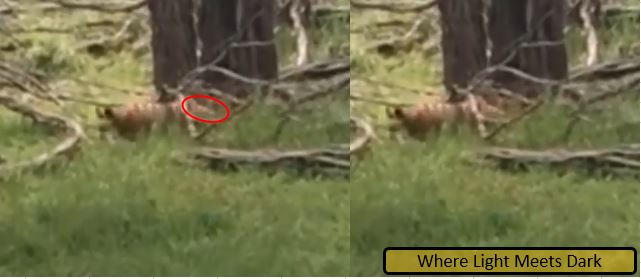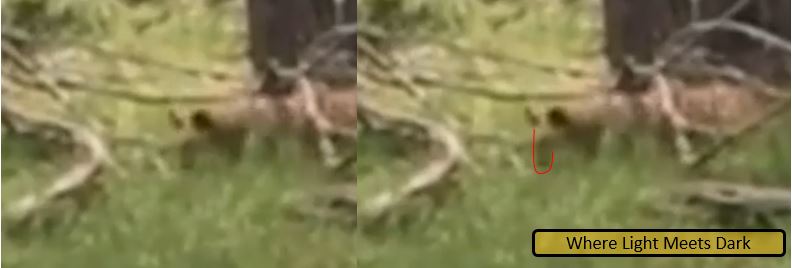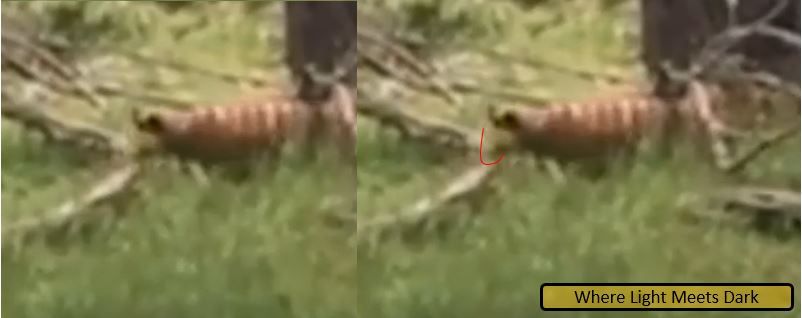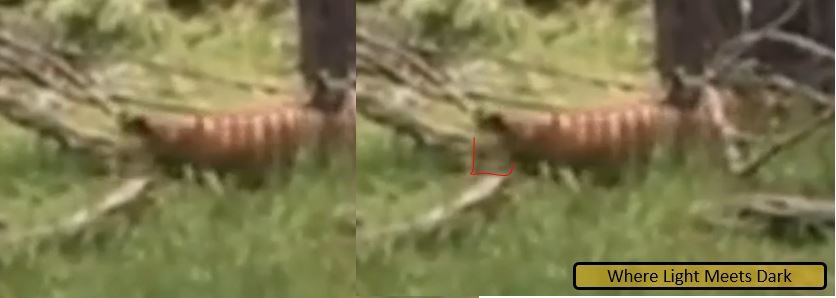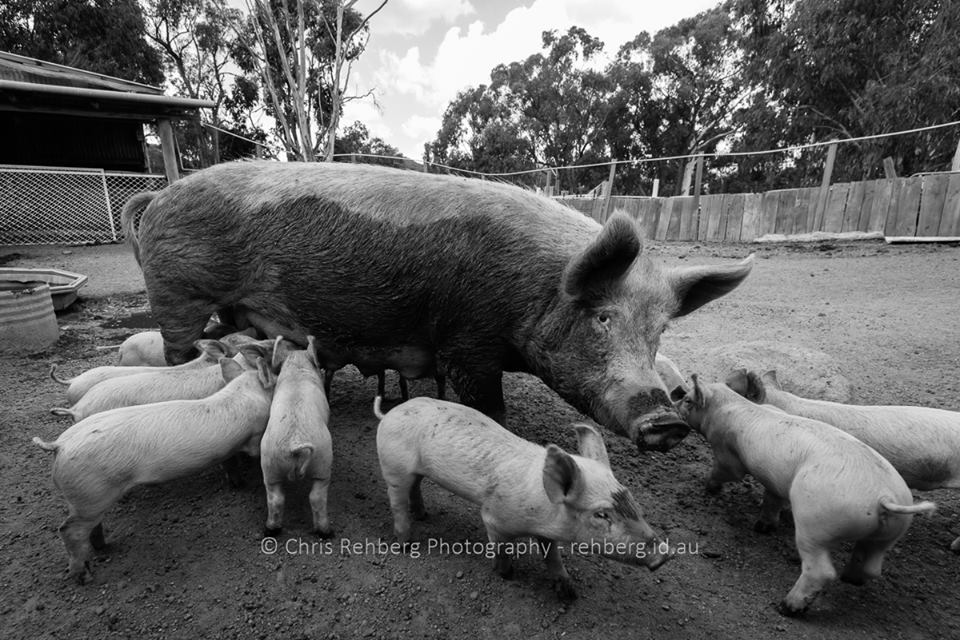Herald Sun thylacine
Overview
In December 2017, Australian news website Herald Sun published an article concerned with de-extinction of the thylacine. At the top of this article by Mark Dunn, a video was presented as possible evidence of the thylacine. No further description, explanation or credit was given for the video or its source.
The Herald Sun article resides behind a paywall - meaning that after loading a certain number of pages from the Herald Sun website, no further premium content may be viewed without a paid subscription. The article may be viewed here.
Analysis video based on the Herald Sun video. This clip repeats the original clip several times, enlarges it and presents still frames at the end. Credit: see "Copyright notice", below.
Still frame from the Herald Sun clip, enlarged. The animal is walking toward the left. Credit: not supplied in source.
Summary of clip
In the video an animal is seen walking from right to left, across frame. There is a tree with many fallen branches lying horizontally, spread out from the tree. The animal appears from out of view, walks out from underneath a fallen branch (which moves in response to the animal brushing against it) and the clip abruptly ends just as the tail of the animal would be visible.
Analysing the evidence
In debunking a hoax photograph earlier this year, a number of criteria were proposed when considering alleged evidence of the thylacine, per below.
- Properties of the evidence itself - Evidence for or against authenticity, within the photographic or video evidence itself.
- Similarity with historical documentation
- Credibility of the back story
- Identity and credibility of the claimant
Back story and claimant
In this case there is no information about the person claiming this to be evidence of the thylacine. Indeed such a claim is not made; the video's caption simply suggests this may be evidence. It is entirely feasible this is an intentionally staged clip for motives unknown, not dissimilar to the Sydney Morning Herald's publication of a staged photograph by Mike Bowers at the time that the Emmerichs photographs were in the news, crafted to illustrate the ease with which a hoax image alleging thylacine persistence may be made.
Staged hoax photograph by Mike Bowers, published in the Sydney Morning Herald (2005) to illustrate the ease with which a staged photograph may be created.
In the case of Bowers' photograph, a cardboard cutout was placed in a garden with tree ferns and intentionally blurred.
Also having no known back story, the last two items of consideration cannot be assessed. This leaves us with considering the clip's similarity to historical documentation and analysing properties of the evidence itself, meaning the construction of the video as well as features of the animal.
Historical documentation
To the knowledge of this author, there is no historical documentation bearing similarity to this footage.
In conclusion, this does not appear to be a reproduction of historical documentation.
Properties of the footage
One thing to be noted about this footage is that the camera is not stationary. This makes it more likely the footage was filmed "hand held" as opposed to having been captured by a motion-triggered camera trap. "Camera motion" as observed in this clip can be produced with a stationary camera trap if the footage is processed after capture, for the purpose of panning or zooming to keep a portion of the clip in the centre of frame. In this case, however, the panning motion appears more consistent with hand held camera work than post production panning.
Faint background audio is suggestive of a bird call, although the tone sounds quite metallic. This might be a property of the recording device. The presence of audio does not preclude a camera trap.
Foreground grass and foliage on the trees and shrubs at the top left and top right corners of the frame are all moving as expected for a light breeze. It seems more probable that this is genuine film footage as opposed to a digital fabrication using computer generated imagery (CGI).
The animal itself brushes its back along the underside of a dead tree limb which, in turn, shakes in response. Again the effect appears quite natural and more likely due to this being genuine film footage as opposed to CGI fabrication.
There are some aspects regarding the visual appearance of the animal itself that seem odd and may involve digital manipulation - particularly regarding the head. These are considered below.
Appearance of the animal
Stripes
The most obvious feature on the animal which is suggestive of thylacine is the set of stripes running vertically down the sides of the animal. Their overall appearance is of pale stripes on a darker background body. Although the thylacine is described as having darker stripes on a paler background colour, several historical (black and white) photographs are suggestive that the markings may appear as pale stripes (ie the spaces between stripes) against an overall darker background. Hence the brightness of the (spacing between the) stripes does not immediately preclude thylacine.
Still frame from the Herald Sun clip showing a striped animal with an indistinct face. Credit: not supplied in source.
Aside from colouration, the stripes have an essentially vertical orientation and even spacing. This is inconsistent with the general appearance of thylacine stripes which are generally thinner toward the front of the animal, and thicken toward the butt of the tail.
In conclusion, the stripes bear only a superficial resemblance to those of the thylacine.
Body shape
Historical photographs show the thylacine as being thicker in the body, dorso-ventrally, at the chest than at the abdomen. The overall appearance of the unidentified animal in this clip is of a relatively consistent dorso-ventral thickness from front limbs to hind. Relative to body length, the mystery animal appears more heavyset than historical photographs of the thylacine.
In conclusion, the heavy-set body of uniform thickness throughout its length is inconsistent with thylacine morphology.
Tail
The clip appears to be cut short just as the animal would reveal its tail emerging from under the overhanging tree limb. There is, however, a single frame prior to this in which the tail seems apparent.
Still frame from the Herald Sun clip showing the mystery animal's tail. Credit: not supplied in source.
The tail appears to be held straight back, at a slight downward angle, somewhat consistent with the thylacine. Relative to body length, it appears shorter than expected for the thylacine although this may be due to limitations in the footage quality or the angle of the tail (if angled away from camera). The tail appears to be striped in a manner consistent with the body. Thylacine tails do not have stripes but some historical photographs appear to show stripes on thylacine tails. This is due to the vertebrae in the tail creating a bumpy texture along the tail, with each bump, in turn, casting a shadow. Where this occurs in historical photographs, there is typically enough space along the tail for 6 to 10 such "stripes". The Herald Sun's mystery clip appears to show 3 or 4 stripes on the tail, at even spacing, which is inconsistent with the thylacine.
In conclusion, the tail's short length and striping appear inconsistent with the thylacine.
Head, face and ears
The last feature to be considered is perhaps the most perplexing: the head. In summary, the head assumes a bizarre appearance - almost as if the animal is wearing a mask or muzzle. The colouration of the face (if it is a face, and not a mask of some sort) is more greyish than the trunk of the animal's body. It is indistinct in appearance. The eyes are indistinct, if present at all. Some frames (as shown under "Stripes", above) do not appear to show the eyes. This may be due to limitations in the recording or playback technology. Other frames appear suggestive of eyes (as shown under "Tail", above) and here the eye region appears simply as a darker grey patch - likely representative of the shadow cast by the eyebrow ridge onto the eye.
The muzzle is very indistinct. Toward the end of the clip the animal appears as if it is about to step over a branch that is lying on the ground in front of it. At this point in the clip the muzzle ought to overlay the branch from our perspective of the animal. Just prior to this branch, the muzzle appears relatively long, but held in a downward pointing position. As the head passes in front of the branch (from our perspective), the length of the muzzle appears reduced - essentially as if it has passed directly behind the branch as might be expected of a poorly executed CGI animation.
Still frame from the Herald Sun clip showing muzzle shape - frame 1. Credit: not supplied in source.
Still frame from the Herald Sun clip showing muzzle shape - frame 2. Credit: not supplied in source.
Still frame from the Herald Sun clip showing muzzle shape - frame 3. Credit: not supplied in source.
Still frame from the Herald Sun clip showing muzzle shape - frame 4. Credit: not supplied in source.
Still frame from the Herald Sun clip showing muzzle shape - frame 5. Credit: not supplied in source.
In frames 1 & 2 above, the muzzle appears elongate and pointing downward. This is more noticeable in the animated clip than in the two still frames. In frame 3 it is expected this elongated muzzle should pass in front of the branch, or that the animal must lift its head but neither of these happens. Rather, the muzzle appears to shorten, or pass behind the branch. In frames 4 and 5 the shape of the muzzle region appears distorted into a somewhat square shape. As was found in the analyses of the Doyle footage, limitations in the design of MPEG encoding can produce such unexpected shapes and artefacts in regions of the frame that are moving.
Although the resolution of the footage is probably just a bit too inadequate for a definitive analysis, the overall impression given, of the head region, while watching the animated clip is, as mentioned, bizarre. It is possible this area of the clip has been digitally modified in post production, or that limitations in the recording or digitisation processes have produced this strange appearance (or that this animal simply has a strange appearance) but there is nothing definitive concerning the face of the animal.
The ears, however, do appear to have a defined shape and dark colouration. They appear to sit atop the (indistinct) face, and are forward facing. Historical still photographs appear to show thylacine ears in a variety of positions. In this clip the ears appear to remain forward-facing, throughout. Due to the indistinct face it is difficult to gauge the relative size of the ears but the impression given is that they are somewhat large and probably rounded.
Identification and conclusion
There may be many animals matching the body proportions and large forward-facing ears of the mystery animal in this clip, but perhaps the nearest match is a pig.
Domestic pig. Credit: Chris Rehberg / Oatley Photography
Any identification is at best speculative due to the limited quality of the footage. Tentative identification of the animal being a pig, or dog, still offers no explanation for the unusual appearance of the face (and lack of forward-facing snout, in the case of a pig), but a sufficient number of visible features offer enough detail to show the animal is inconsistent with the thylacine.
Finally, it seems very odd that a news piece on thylacine genetics should include this otherwise unknown footage regarding "potential evidence" of the thylacine without any credit or further information. If readers, or Herald Sun staff, are able to provide further information about this footage, I would be happy to reassess the clip in light of new information.
Acknolwedgements
Thank you to Pål Nikolai for alerting me to the news article and Brendan Kays for preparing and contributing the video.
Copyright notice
The video clip published in this article is hosted on YouTube and is an analysis of the clip published by Australian news media website Herald Sun in December 2017. In this analysis clip the original video is enlarged and slowed down and a few still frames are given at the end.
The copyright owner of the original clip is unknown as it was published by the Herald Sun in Australia without any credit. It is incorporated into the analysis video published here for the purpose of critical analysis per this article and as such, is reproduced under the terms of Fair Dealing in Australian copyright law.
Credit for the analysis video: Brendan Kays.
Composite images on this page: Chris Rehberg / Where Light Meets Dark.
